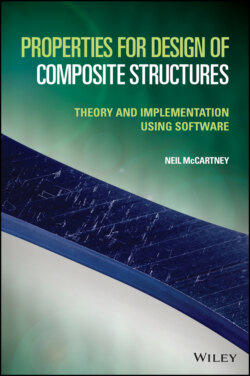Читать книгу Properties for Design of Composite Structures - Neil McCartney - Страница 63
4.2.2 Maxwell’s Methodology for Estimating Transverse Conductivity
ОглавлениеThe first stage is to consider the perturbing effect of an isolated cluster of parallel fibres, having different sizes and properties as described in Section 4.1, in the infinite matrix at very large distances from the cluster. The transverse thermal conductivity of the fibres of type i is denoted by κTf(i). The cluster is assumed to be homogeneous regarding the distribution of fibres, and leads to an effective transverse thermal conductivity κTeff for the composite. The perturbing effect of the fibre cluster is estimated by superimposing the perturbations caused by each fibre and recognising that, at large enough distances, all the fibres in the cluster can considered as located at the origin that is situated at the centre of one of the fibres in the cluster. Thus, for the case of multiple phases, the temperature distribution (4.7) for the matrix is generalised to the form
(4.8)
The cluster of all types of fibre is now considered to be enclosed in a cylinder of radius b such that the volume fraction Vfi of fibres of type i within the cylinder of radius b is given by (4.1). On using (4.7) the temperature distribution in the matrix outside the cylinder of radius b is then given by
(4.9)
The second stage is to equate the perturbation terms in (4.8) and (4.9) (i.e. the second terms on the right-hand side) so that, on using (4.1), the effective thermal conductivity of the multiphase cluster of fibres may be obtained from the relation
(4.10)
The effective thermal conductivity of the multiphase fibre composite is then given by
(4.11)
The bounds for the conductivity of a multiphase composite are given by Torquato [5] which may be written in the following simpler form, having the same structure as the result (4.10) derived using Maxwell’s methodology
(4.12)
where κmin is the lowest value of conductivities for all phases, whereas κmax is the highest value.
The effective axial thermal conductivity of the unidirectional composite is given by the following mixtures rule
(4.13)
The validity of this relationship arises from the fact that the temperature distribution is such that there is no heat flow across the fibre/matrix interfaces. The temperature is linear in the axial direction having the same gradient in both fibre and matrix.
